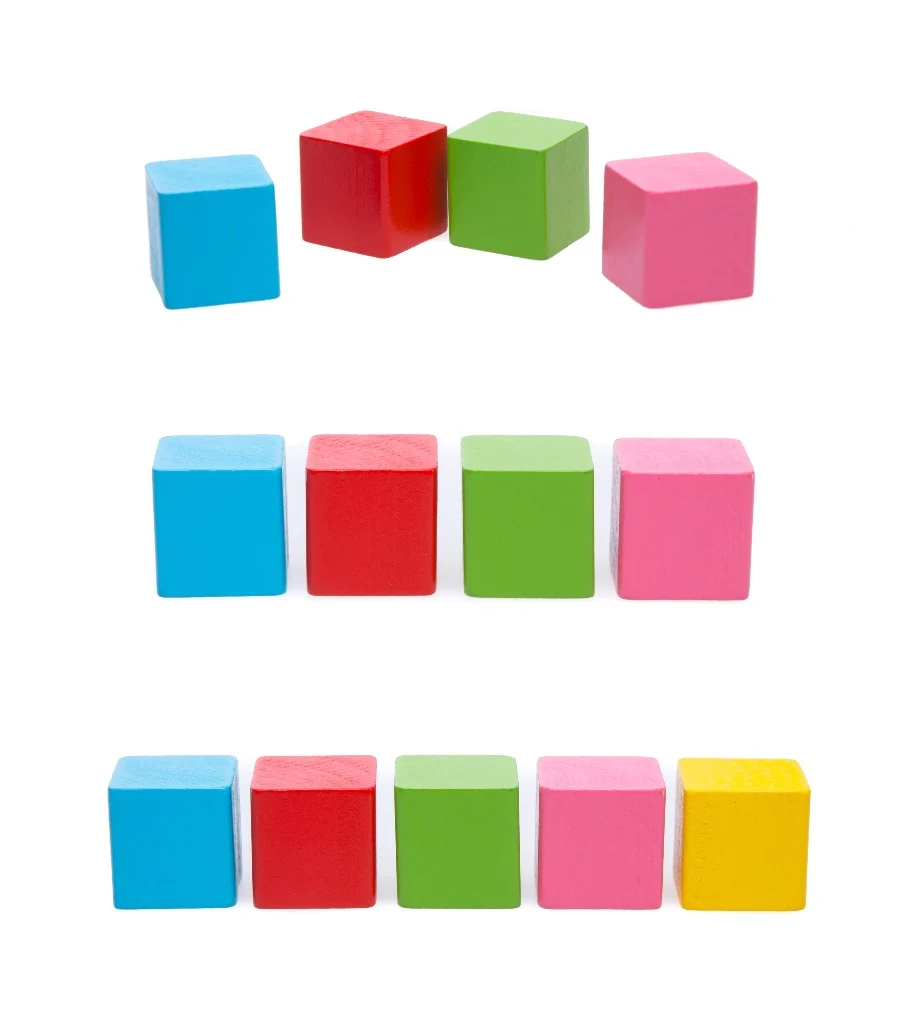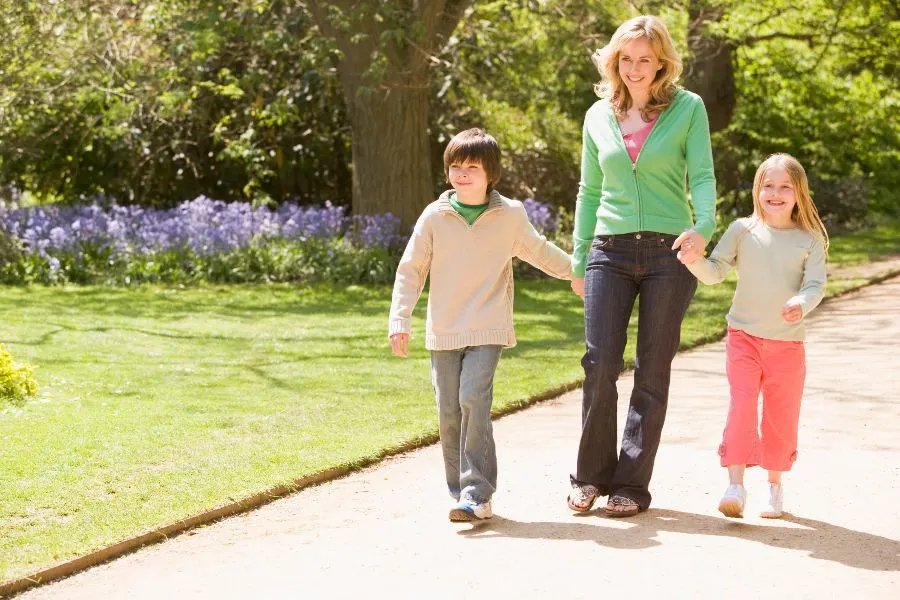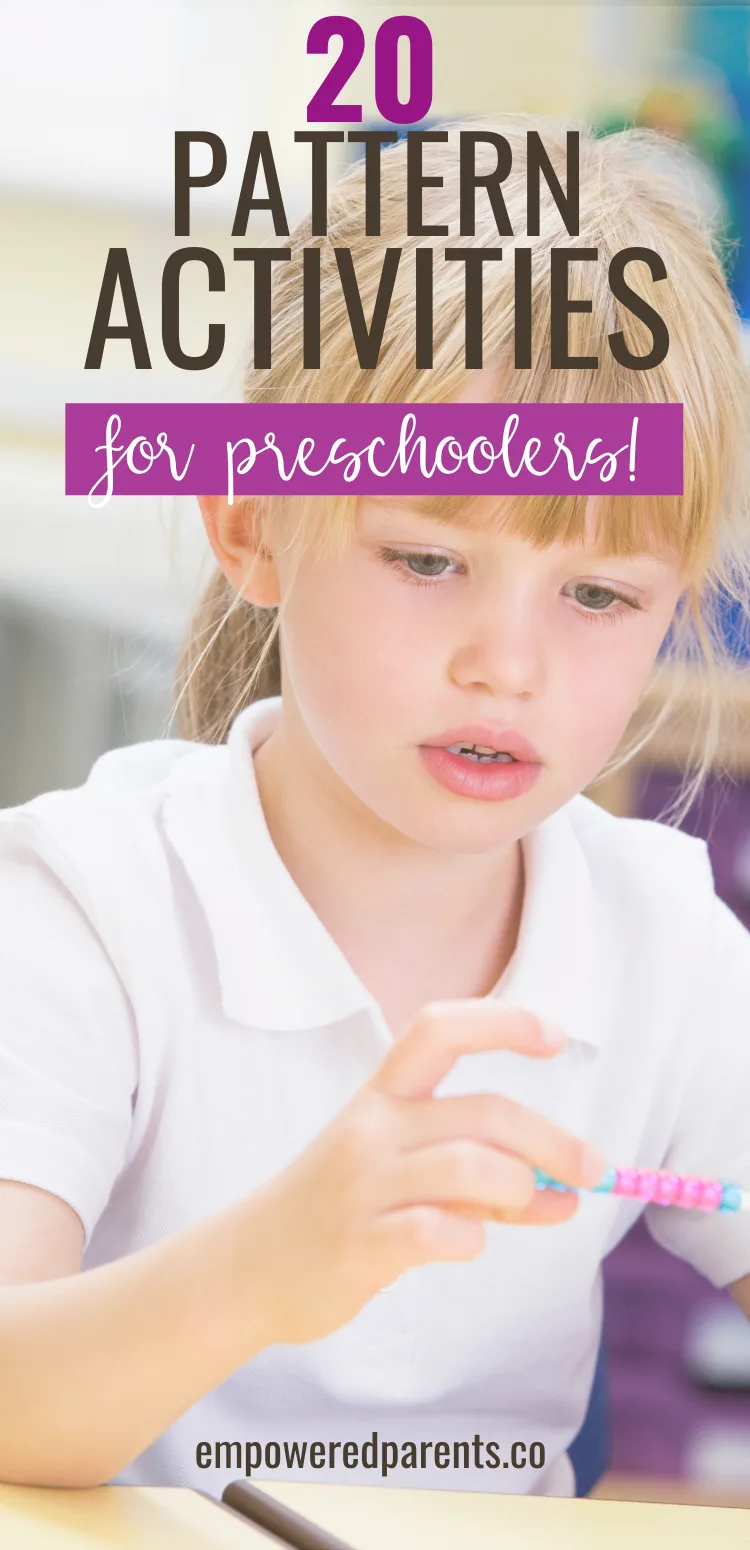Here are some pattern activities for preschoolers to help you teach the concept in class or at home in a simple, fun and hands-on way.
Why are Patterns Important for Preschoolers?
Learning about patterns is an important early maths skill.
Kids start off learning about patterns in the environment or identifying them with colours and shapes.
With maturity they are able to spot the patterns when, for example, skip counting in threes, adding or learning multiplication.
Later on, they learn complex mathematical patterns.
Patterns are also found in literacy.
Words and letters are made up of patterns – both in the shapes that make them up, and in the sounds they form (such as rhyming patterns).
From around the age of four, the first patterns start emerging in children’s drawings (see the stages of drawing).
How Do You Teach Patterns to Preschoolers?
There are many ways to introduce the concept of patterns to preschoolers, but the best way is through hands-on experiences and play.
To learn about patterns, children must first be able to analyse the information, make sense of it, identify the pattern and then continue it or re-create it.
Concrete Experiences
Before introducing patterning worksheets children needs lots of concrete experiences to fully grasp the concept.
The best way for them to learn patterns – and many other concepts – is through a concrete-pictorial-abstract approach.
They are first able to understand a pattern by manipulating physical objects (such as blocks), then by looking at a picture of a pattern (such as shapes).

Lastly, they learn to grasp abstract patterns – such as completing a number pattern.
Preschoolers are mostly in the concrete phase so they will do best with hands-on activities.
The concrete-pictorial-abstract approach is actually a great way to teach maths to kids.
Patterns in the Environment
The first patterns children see are in their environment – a pattern on an item of clothing, patterns on a leaf or a pattern on the floor tile.
Point these out whenever you see them, explaining what the pattern is.
Familiar Patterns
Kids then learn about patterns using familiar concepts such as shape, colour, size, texture, attributes, etc.
Later they can see patterns in numbers and words.
Patterns Follow a Rule
Teach kids that patterns follow a rule and that they repeat – for example, the zebra has a black stripe, then a white stripe, and then the set repeats.
Ways to Make Patterns
When first introducing patterns or asking children to follow them, start with a simple rule in the A/B pattern, such as one red block, one blue block, etc.
Also, use only one property – such as a pattern of colour, size, shape, etc.
Later, you can use more complex patterns (such as A/B/C or A/A/B) and mix properties together (such as colour and shape).
Skills That Help Teach Patterning
Cognitive skills like matching, sorting and sequencing will help your child to grasp and develop patterning skills.
When a child matches items by their properties – such as matching socks according to colour and size – they learn that things have various characteristics and can be grouped and sorted in various ways.
Get kids to sort and categorize during play or make chores fun by turning them into a game.
20 Simple Pattern Activities for Preschoolers
Here are a few simple, hands-on patterning activities. The last few activities will help set the foundation for learning patterns.
1. Make a Train
For a life-size experience with a pattern, get kids to make a chair train using chairs in two different colours (red chair, blue chair, red chair, blue chair, etc.)
They can then sit on the train and pretend to go for a ride.
Or, make a train with the kids themselves. Try a pattern of boy/girl, blonde/brunette or whatever else you can think of.
Get them to place themselves into a line following the rule of the pattern – one boy, then one girl, then repeat.
2. Block Patterns
The simplest pattern activity can be done with a set of blocks.
Build the beginning of the pattern and ask kids to continue it. Challenge them to tell you what the rule is (one red block, two yellow blocks, repeat).
Start with a simple A/B pattern and then change it up – A/A/B, A/B/C, A/B/B, etc.
Also, change the properties. Make a block pattern with colours, then different shapes (cube, rectangular, prism, etc.) or sizes (big block, little block, etc.)
Here are more ways to learn about colours.
3. Shape Patterns
The pattern activity above can also be done with plastic/wooden shapes or even paper cut-outs.
Try these shape-recognition activities too.
4. Paper Plate Patterns
Using a simple paper plate and pegs in different colours, get children to place the pegs around the plate, in a particular pattern.
You could also paint the pattern onto the plate by making strokes of the pattern around the edges, and then get the kids to match the pegs and follow the pattern around the plate.
5. Cereal Bracelet
Use cereal loops (or something else that’s fun and edible) and thread them onto a string in a pattern sequence (start with just two colours for young children).
Kids can nibble them through the day once they’ve completed them and tied them to their wrists.
6. Beads
Beads can be used in multiple ways to make patterns.
- Follow a simple pattern and thread beads onto string, shoe laces or pipe cleaners
- Make a pattern necklace
- Get out some paper or poster board and liquid glue and make a pattern by sticking the beads in a line

7. Buttons
Buttons are also versatile items that can be used in so many educational ways.
Make simple patterns such as:
- Red button, yellow button, repeat
- Big button, small button, repeat
- Round button, square button, repeat
And for older children:
- Red button, blue button, pink button, repeat
- Two red buttons, 1 yellow button, repeat
- Two big buttons, one small button, repeat
Older preschoolers can also thread buttons to make a necklace.
Here are 17 awesome button activities for preschoolers.
8. Macaroni Necklace
As a variation on making a bead or button necklace, make a necklace using dried macaroni.
Follow a pattern based on the shape or size/length of the macaroni, or paint them in different colours before threading them in a pattern.
9. Clapping Patterns
Play a game of listening to the pattern.
Clap out a simple sequence and get kids to copy it by clapping it back to you.
Here are some examples:
- clap – – clap – – clap
- clap – – clap-clap – – clap
- clap-clap – – clap
Vary the pace and number of claps.
10. Clapping Games
Playing traditional clapping games is a great way to learn patterns naturally.
Some of them are pretty challenging so teach younger preschoolers simpler clapping sequences.

11. Paper Tearing
Make quick and easy patterns when first introducing the concept by giving kids sheets of paper in two colours and getting them to tear strips and place them in a pattern.
Not only will they learn the concept but they will get fine motor practice from this tearing activity.
12. Plastic Cups
Provide plastic cups in different colours and then make patterns with them.
Or, create a pattern based on the material of the cups – plastic cup, paper cup, repeat.
13. Nature Patterns
Go outdoors and collect natural materials – twigs, fallen flowers and leaves, etc.
Start a simple pattern – such as leaf, flower, leaf, flower – and get kids to identify and follow the pattern.
Take it a step further and glue the items onto paper to make a pattern collage.
14. Baking
Next time you do some baking – also a highly educational activity – introduce patterns into it.
Make stripes of icing on your cupcakes with different colours or make patterns with the decorations.

15. Movement Patterns
Play a game where kids follow a pattern of movements that you demonstrate.
They can then continue the pattern and try to make up some movement sequences.
Here are two examples:
- Clap, click, turn around, repeat
- Jump, nod and put your hands up
This takes a lot of coordination and concentration and will help teach kids to feel the pattern and experience it at the level of their whole body.
Use games like Simon Says as an opportunity to introduce patterns.
16. Spot Patterns in the Environment
Make sure you notice and point out patterns in the environment – they are everywhere.
Find them on clothes, on the patio outside, on your pet cat and on stripy leaves.
You could even go on a pattern-finding walk and challenge kids to spot patterns around you.

17. Songs and Rhymes
While this may seem like an odd choice for a patterning activity, singing songs and reciting poems and rhymes is a great way for a child to become familiar with sound patterns.
They learn about rhythm, rhyme, syllables (beats in a word), stress patterns in a song, alliteration, etc.
Nonsense rhymes are wonderful for learning rhyming patterns.
18. Stories
Children can also learn about patterns through listening to stories.
The Julia Donaldson books are filled with patterns – think What the Ladybird Heard, The Paper Dolls or The Gruffalo.
The scenes follow set patterns and there is a lot of repetition, which makes it easy for children to follow along and predict what’s coming.
Children learn through these types of stories that there is a sequence of events and they start to pick up on the pattern of the particular story.
More examples of popular stories that follow patterns are The Three Little Pigs and Goldilocks and the Three Bears.
19. Sorting Socks
This may sound overly basic but when your kids are toddlers, get them to find the matching pairs of socks, or sort the laundry into piles.
While you’re at it, clean out and sort the cutlery drawer, sort toys onto the shelf and do any other chores that double as educational activities.
These will also develop your child’s ability to spot patterns in things and learn that objects have different qualities:
- These socks are large and those are tiny.
- This sock has red spots so it doesn’t match the one that has blue spots.
- This top has white and pink stripes.
20. Puzzles
Puzzles are excellent for developing a child’s visual perception, which is an important skill for reading.
Visual perception can be developed through play activities and helps children identify and understand patterns.


Marcela
Friday 10th of February 2023
Excellent information. Thank you.
Tanja Mcilroy
Friday 10th of February 2023
Thanks, Marcela!